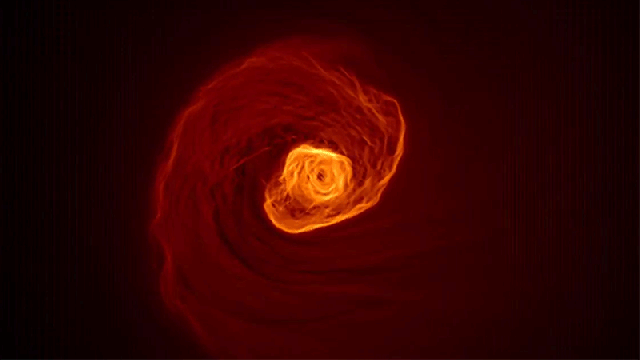It’s another casual day in space discovery: Apparently, an international team of scientists has found a giant wave of hot gas chugging along through the Perseus galaxy cluster, located about 250 million light years away. By combining data from NASA’s Chandra X-ray Observatory with radio observations and computer simulations, the researchers have attempted to demystify the strange phenomenon — and in doing so, have created one hell of a visual.
Image: NASA’s Goddard Space Flight Center
Their idea is essentially that billions of years ago, a smaller galaxy cluster brushed up against the Perseus cluster, causing Perseus’ supply of interstellar gas to “slosh” around. The result is a massive, tsunami-like wave — about 200,000 light years across — that glows in X-ray. It’s kind of like making a very half-arsed Arnold Palmer, if you poured some lemonade in a jug of iced tea and stirred it around for billions of years.
Observations of this intergalactic tsunami have revealed a number of striking features, including a concave “bay” that curiously produces no radio emissions.
“Deep observations of nearby galaxy clusters with Chandra have revealed concave ‘bay’ structures in a number of systems… which have similar X-ray and radio properties,” the researchers wrote in their paper, which have been published in the June 2017 edition of Monthly Notices of the Royal Astronomical Society. “These bays have all the properties of cold fronts, where the temperature rises and density falls sharply, but are concave rather than convex.”
The team patched together data from Chandra and elsewhere to further investigate the phenomenon, and created this video, showing the strange feature embedded in the larger swirl of hot gas:
According to NASA, individual waves churning within the tsunami are likely to be very large, very intense versions of something called a Kelvin-Helmholtz wave, which emerge when there’s a difference in velocity between two fluids. This occurs here, too, in the clouds in Earth’s atmosphere.
“We think the bay feature we see in Perseus is part of a Kelvin-Helmholtz wave, perhaps the largest one yet identified, that formed in much the same way as the simulation shows,” lead scientist Stephen Walker at NASA’s Goddard Space Flight Center said in a statement. “We have also identified similar features in two other galaxy clusters, Centaurus and Abell 1795.”
Good thing there’s some sort of scientific explanation for all of this, or else someone who is definitely not me might suggest this is the result of a massive alien fart.
